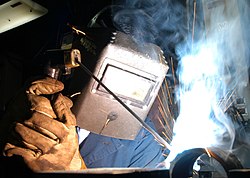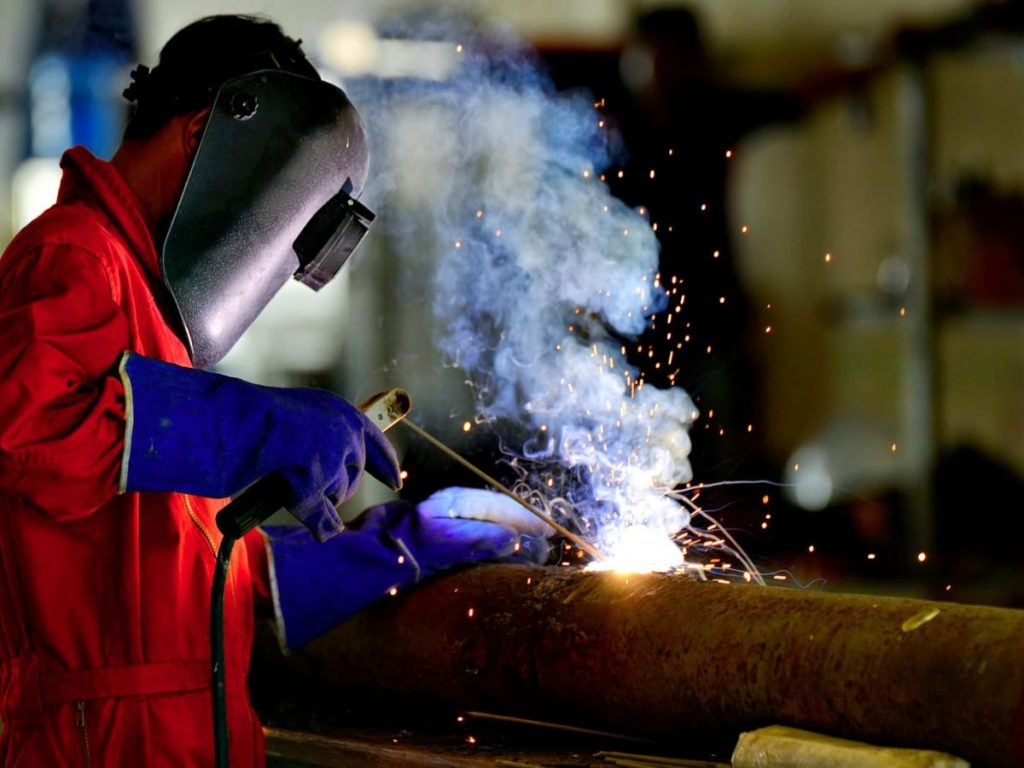Arc welding is a popular welding process that uses electricity to create an arc between an electrode and the material being welded. This process can be used to join metals such as steel, aluminum, and stainless steel. In this article, we will provide an overview of the arc welding process, including its uses, advantages, and disadvantages.
How Does Arc Welding Work?
Arc welding is a type of welding that uses an electric arc to create heat to melt and fuse metals together. It is a popular welding method because it is relatively easy to learn and can be used on a variety of materials, including steel, aluminum, and stainless steel. In this blog post, we’ll take a closer look at how arc welding works and some of the benefits of using this type of welding.
The Basics of Arc Welding
An arc welder uses an electrode—a metal rod with a conductive tip—to create an electric arc. The arc welder also has a ground clamp that completes the circuit by grounding the workpiece. When the electrode touches the workpiece, an electric current flows from the electrode to the workpiece, causing the metal to heat up and melt. The molten metal then fuses the two pieces of metal together.
There are three main types of arc welders: shielded metal arc welders (SMAW), gas tungsten arc welders (GTAW), and flux-cored arc welders (FCAW). SMAW welders are the most common type of arc welder; they’re portable, relatively inexpensive, and easy to use. GTAW welders are typically used for thin-gauge materials and require more skill to use than SMAW welders. FCAW welders are similar to SMAW welders but use a consumable wire electrode instead of a metal rod.

Benefits of Arc Welding
There are many benefits to using arc welding, including its versatility, portability, and affordability. Arc welding can be used on a variety of materials, including steel, aluminum, and stainless steel. It’s also a portable welding method—welders can bring their equipment with them to job sites as needed. And since welding doesn’t require highly skilled labor, it tends to be less expensive than other types of welding methods.
There are three main types of arc welding:
Arc welding is a type of welding that uses electricity to create an arc between an electrode and the base material. The electrode is then used to melt and join the two pieces of metal together. There are three main types of arc welding: stick welding, MIG welding, and TIG welding. In this blog post, we’ll discuss the differences between these three types of arc welding so that you can make an informed decision about which one is right for your next project.
Shielded Metal Arc Welding
Shielded metal arc welding is the most common type of arc welding. It is also sometimes referred to as “stick welding.” In this type of welding, an electrode is attached to a holding device, called a stinger. The electrode is then dipped into a pool of molten metal, called a weld pool.
As the electrode is consumed, more molten metal is added to the weld pool. This type of welding is typically used for heavy-duty applications, such as repairing bridges or lifting equipment. It is also frequently used in the construction industry. One of the main advantages of shielded metal arc welding is that it can be used on almost any type of metal, including aluminum and stainless steel.
Advantages of Shielded Metal Arc Welding
One of the main advantages of SMAW is that it can be used on a variety of metals, including carbon steel, stainless steel, cast iron, and aluminum. SMAW is also relatively easy to learn compared to other welding processes. And because no filler metal is required—the electrode itself serves as both filler metal and shielding gas—SMAW is less expensive than other welding processes.
Disadvantages of Shielded Metal Arc Welding
Because SMAW is a manual process, it can be more time-consuming than other welding processes that are automated or semi-automated. This is especially true for large projects where speed is essential. In addition, SMAW can produce more welding defects than other processes because it relies heavily on operator skills. Poor technique can result in problems like porosity (tiny holes in the weld), slag inclusions (pieces of solidified flux), undercut (excessive melting of base metal at weld edge), and poor bead appearance.
Gas Metal Arc Welding
Gas metal arc welding sometimes referred to as “MIG welding,” is a type of arc welding that uses a wire electrode. The wire electrode is fed through a hose from a spool. As the wire electrode moves through the hose, it is electrically charged. This electrical charge creates an arc between the electrode and the base material. The heat from the arc melts the wire electrode as it is deposited onto the workpiece, creating a solid joint. The characteristics of the electrode, such as its composition and diameter, can greatly impact the welding process, including the quality of the weld and the overall efficiency of the operation. By carefully selecting the appropriate electrode characteristics for the specific welding application, welders can ensure precise control over the deposition of metal and the overall welding process.
The main advantage of gas metal arc welding over other types of arc welding is that it is much faster. This makes it ideal for large-scale projects where time is of the essence. Additionally, gas metal arc welding produces less slag than other types of arc welding. Slag is a byproduct of the weld that can cause defects in the finished product.
Benefits of GMAW Welding:
1. Speed – GMAW is one of the fastest welding processes, making it perfect for applications where time is of the essence.
2. Portability – Many GMAW power sources are portable and can be used in a variety of locations without the need for external gas cylinders.
3. Fume reduction – As mentioned before, GMAW produces very little welding fumes thanks to the shielding gas that protects the weld pool. This makes it ideal for indoor applications or environments where fume extraction is not possible.
4. Versatility – GMAW can be used on a variety of metals, including steel, aluminum, and stainless steel. Additionally, it can be used for both thin and thick materials.
5. Ease of use – GMAW is considered one of the easiest welding processes to learn, making it perfect for those who are new to welding or those who need to complete a quick repair job.
Flux-Cored Arc Welding
Flux-cored arc welding is similar to gas metal arc welding in that it uses an electrode that is fed through a hose from a spool. However, instead of being made from solid wire, the electrode in flux-cored arc welding contains a core of flux powder. This flux powder helps to shield the weld from contamination.
Like gas metal arc welding, flux-cored arc welding has the advantage of being very fast. Additionally, it can be used in both indoor and outdoor settings since there is no need for external shielding gas. However, one downside to flux-cored arc Weldingis that it can produce more fumes than other types of welds.
Advantages of Flux-Cored Arc Welding
One of the main advantages of FCAW is that it can be used on both thin and thick materials. This makes it an ideal choice for projects that require welding on multiple types of materials.
Another advantage of FCAW is that it’s relatively easy to learn when compared to other types of welding. This makes it a great option for those who are just starting out in welding or for those who don’t have a lot of experience.
Lastly, FCAW produces very little smoke and fumes when compared to other types of welding. This makes it much safer to use, both for the welder and for anyone who might be nearby.
Disadvantages of Flux-Cored Arc Welding
While FCAW has many advantages, there are also some disadvantages to consider before using this type of welding. One disadvantage is that FCAW can be more expensive than other types of welding because it requires special equipment and consumables.
Another disadvantage is that FCAW can produce more spatter than other types of welding. This means that there will be more clean-up required after completing a weld.
Advantages of Arc Welding
There are many advantages to using arc welding over other methods of joining metals. Some of these advantages include:
-Arc welding is fast and efficient, making it ideal for large projects.
-Arc welding can be used on a variety of materials, including steel, aluminum, and stainless steel.
-Arc Welding is relatively easy to learn and can be performed by amateurs and professionals alike.
Disadvantages of Arc Welding
There are also some disadvantages to using arc welding which include:
-Arc welding can be dangerous if proper safety precautions are not taken. This includes wearing proper clothing and using the correct safety equipment.
-Arc welding produces harmful fumes that can be harmful to your health if you are not properly protected.
-Arc welding produces UV rays that can damage your eyes if you are not properly protected.
The Many Uses of Arc Welding
One of the most common uses for arc welding is in the construction industry. Arc welders are often used to weld together steel beams and other large pieces of metal. This type of welding is also used to make repairs to bridges, roads, and other infrastructure.
Arc welding can also be used for artistic purposes. Sculptures and metal art often make use of arc welds to join together different pieces of metal. Some artists even use arc welders to create “drawings” made out of melted metal droplets.
Finally, arc welding is sometimes used in auto body work. This type of welding can be used to repair dents, rust spots, and other damage on cars and trucks. It can also be used to create custom parts and accessories for vehicles.
Conclusion:
Overall, arc welding is a fast, efficient, and popular method for joining metals. However, it is important to take proper safety precautions when performing this type of work as it can be dangerous. If you are considering undertaking an arc welding project, be sure to do your research and take all necessary safety precautions.

